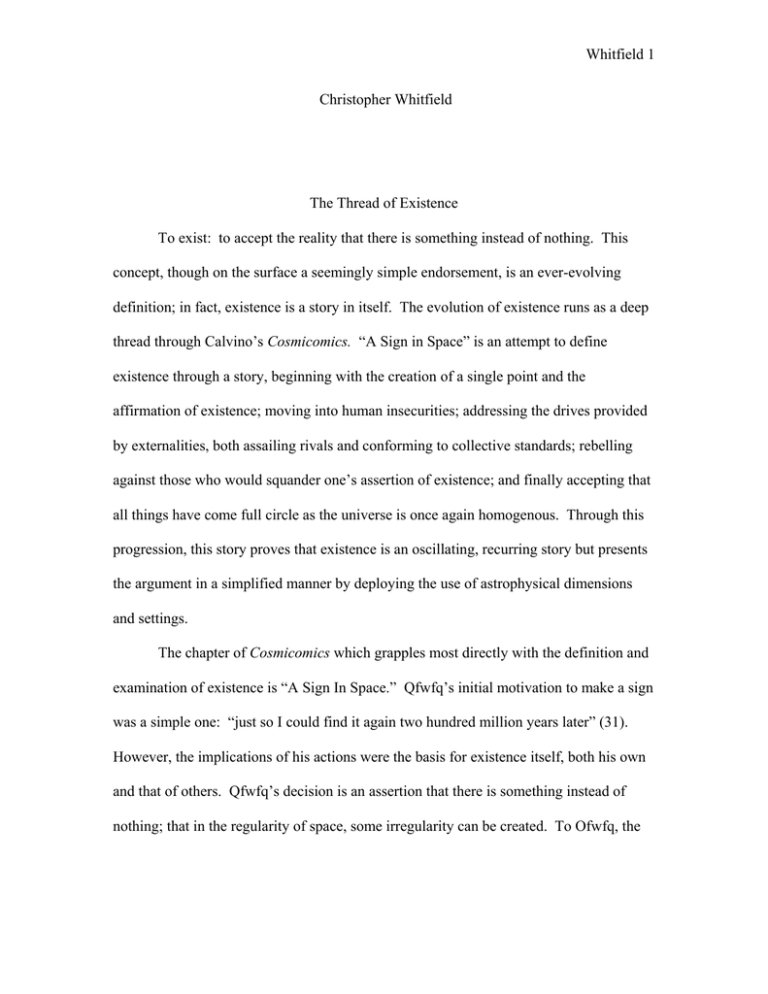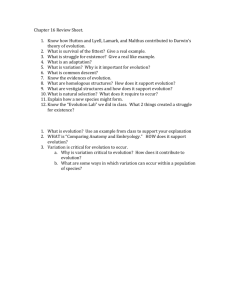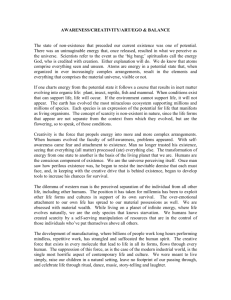Whitfield 1 Christopher Whitfield The Thread of Existence
advertisement

Whitfield 1
Christopher Whitfield
The Thread of Existence
To exist: to accept the reality that there is something instead of nothing. This
concept, though on the surface a seemingly simple endorsement, is an ever-evolving
definition; in fact, existence is a story in itself. The evolution of existence runs as a deep
thread through Calvino’s Cosmicomics. “A Sign in Space” is an attempt to define
existence through a story, beginning with the creation of a single point and the
affirmation of existence; moving into human insecurities; addressing the drives provided
by externalities, both assailing rivals and conforming to collective standards; rebelling
against those who would squander one’s assertion of existence; and finally accepting that
all things have come full circle as the universe is once again homogenous. Through this
progression, this story proves that existence is an oscillating, recurring story but presents
the argument in a simplified manner by deploying the use of astrophysical dimensions
and settings.
The chapter of Cosmicomics which grapples most directly with the definition and
examination of existence is “A Sign In Space.” Qfwfq’s initial motivation to make a sign
was a simple one: “just so I could find it again two hundred million years later” (31).
However, the implications of his actions were the basis for existence itself, both his own
and that of others. Qfwfq’s decision is an assertion that there is something instead of
nothing; that in the regularity of space, some irregularity can be created. To Ofwfq, the
Whitfield 2
sign does not solely represent a point in space to find in the future, but an anchor of
personal identity.
“The sign served to mark a place but at the same time it meant that in that place
there was a sign (something far more important because there were plenty of
places but there was only one sign) and also at the same time that sign was mine,
the sign of me, because it was the only sign I had ever made and I was the only
one who had ever made signs. It was like a name, the name of that point, and also
my name that I had signed on that spot.” (32-33)
This is the first step in the evolution of existence as it is the egocentric claim that one is
unique, paralleling closely with humans’ self-centered drives.
Of course, a formless Qfwfq who spends hundreds of millions of years simply
waiting for the verification that his sign is still exactly where he left it all those years may
provide a difficult parallel in evaluating our own existence. Still, are Qfwfq’s pursuits
any different than our own aims to leave a mark on our respective universe? They take
place with a different backdrop, and in the eyes of an ambiguous character, but preach the
same drive to affirm one’s place in the world.
Even after Qfwfq’s affirmation of his existence in the universe, the insecurity
associated with potentially losing this is abound in Qfwfq’s experience as well. It is as
human as our fear of being overlooked in this world.
“I had lost everything: the sign, the point, the thing that caused me—being the
one who had made the sign at that point—to be me. Space, without a sign, was
once again a chasm, the void, without beginning or end, nauseating, in which
everything—including me—was lost” (35).
Whitfield 3
Qfwfq possesses no sense of direction or personal identity in the absence of the sign, just
as one who has made a mark sees that influence vanish and is thrown into despair.
Ofwfq’s description provides a wholly pessimistic view encompassing his loss of identity
in the event of him being unable to find the sign. This outlook is keenly human, as we
fear others forgetting us, and so the subsequent step is to assail those who would have us
forgotten.
Appropriately, when Qfwfq cannot recognize his own sign upon returning to its
original location, there occurs a detachment from Qfwfq’s personal drive to prove his
own existence: he begins to define himself by a comparison with the perpetrating eraser.
“It was clear that his sign had nothing to mark except Kgwgk’s intention to
imitate my sign, which was beyond all comparison. But at that moment the
determination not to let my rival get the better of me was stronger than any other
desire: I wanted immediately to make a new sign in space, a real sign that would
make Kgwgk die of envy.” (35)
Just as the human drive to leave a mark on the world was clearly paralleled despite the
vastly different backdrop of Cosmicomics, this envious drive presents perhaps the more
substantial human tendency, to live by comparison to others. Qfwfq’s envy revitalizes
his sign-making attempts and becomes his chief driving force. He no longer lives for his
own existence but to spite the existence of another.
Furthermore, this driving force evolves into a sort of “relative existence,”
meaning that Qfwfq begins to define himself based on how he fits into the universe,
taking into account those external influences that he was previously ignorant of, or at
least did not care to recognize. “In this new sign of mine you could perceive the
Whitfield 4
influence of our new way of looking at things, call it style if you like, that special way
that everything had to be, there, in a certain fashion” (36). This definition presents the
most convincing parallel with human nature, as Qfwfq’s reference is to “our new way of
looking at things,” suggesting a collective opinion on what signs are acceptable or not.
To expand upon the human parallel, we realize that Qfwfq does not really exist in
this period of “relative existence.” Rather, his existence is fake, motivated solely by the
external influences. Although his sign is his own, the design of it reflects less upon his
nature than it does upon the nature of the world; and if the sign is truly just a microcosm
of the universe, it should be as regular as any other portion and therefore not stand out at
all. Qfwfq’s drive to exist as an individual becomes absorbed by the existence of all that
surrounds him, but he does realize this quickly.
In the same way that styles come and go and the collective opinion changes and
evolves quickly in our world, Qfwfq questions the sign he made in light of these
acceptable fashions. “I was ashamed of that sign which went on through the centuries,
being passed by worlds in flight, making a ridiculous spectacle of itself and of me and of
that temporary way we had had of seeing things” (36). Indeed, this mindset parallels
again with human nature: one may leave a place or group with a certain impression and
there is nothing that can be done to retroactively fix that mark made upon those people.
The regret is that, to that group of people, one’s existence is defined in a sign: an
immovable, unchanging constant that remains for an extended period of time.
Sometimes one is given a chance to erase this sign and make a new one, but the
scar from the former remains. This sign’s mark was made on both the skin of the world
and oneself. “As the galactic years passed the erasures tended to fade into space, and
Whitfield 5
beneath them what I had drawn at those points {. . .} began to reappear” (37). The drive
to create a new sign is deterred by this scar and the regret resulting from the insecurity of
what the sign will mean in the future.
The next step in the evolution of existence is again one of spite of, and can be
defined this time as a frustrated rebellion; however it is no longer a drive of creation, as
before, but of destruction. “So, unable to make true signs, but wanting somehow to
annoy Kgwgk, I started making false signs, notchings in space, holes, stains, little tricks
that only an incompetent creature like Kgwgk could mistake for signs” (37). By doing
this, Qfwfq removes the meaning from the signs he originally made to define his
existence. The points of the universe become cluttered with signs of all types to the point
that they lose their definition of irregularity and became a regular part of the universe.
Just as before, when Qfwfq’s false definition of existence effectively implied that
he did not exist, these false signs do the same. In fact, both false definitions occur in the
presences of externalities. The implication is that existing for another or in spite of
another is false and in these periods one does not truly exist. This is especially true when
compared to the Qfwfq’s initial intentions for existence, which were entirely egocentric.
Beyond just losing their uniqueness, the signs cease to be parameters of the
universe by which to measure oneself and space. “In the universe now there was no
longer a container and a thing contained, but only a general thickness of signs
superimposed and coagulated, occupying the whole volume of space” (39). These points
of reference inevitably partition space; Qfwfq previously defines these universal
partitions as “an outside with an inside in it” (24). These conditions allow space to be
Whitfield 6
comprehendible, providing a sense of direction and the first indication of boundaries,
which Qfwfq apparently finds comforting; such is the opinion of human nature.
The breakdown of these partitions, considering that “through the signs a
continuity had been established with no precise boundaries any more” (39), causes the
unraveling of existence’s thread. Signs that once defined Qwfwq’s existence and that of
others were no longer signs because they could not be found upon the return to the
original location. Their uniqueness was lost to the sea of signs that all attempted to
define separate singular existences but failed when the irregularity of the universe was
squandered.
“There was no longer and way to establish a point of reference: the Galaxy went
on turning but I could no longer count the revolutions, any point could be the
point of departure, any sign heaped up with the others could be mine, but
discovering it would have served no purpose, because it was clear that,
independent of signs, space didn’t exist and perhaps had never existed. (39)
The assertion at the conclusion of this chapter leaves a sour taste in one’s mouth,
an elusive stab at the broader implications of this evolution of existence. The struggle of
humans in the modern world to define themselves in a crowded, meaningless and
unforgiving atmosphere shoulders a dismal outlook. Qfwfq’s story could easily begin as
immediately as it ends, since in the universe, yet again, “nothing could be distinguished
from anything” (31). Indeed, the evolution of existence is not one which always moves
toward a definition per say but oscillates in a manner akin to the reestablishment and
disestablishment of the human acceptance of his or her place in the world.
Whitfield 7
This evolution ties strong parallels with human nature in many ways as a
consequence of the human-like qualities of Qwfwq, but the astrophysical background
clearly presents a potential differentiation. The employment of this backdrop allows the
simplification of the concepts and aids a deeper understanding of this evolution taking
place. The marks and influences deployed by Qfwfq and others are clear in that they are
simply signs surrounded by emptiness. The characters are simple in their drives and
intentions, spending hundreds of millions of years focusing on the task of rediscovering a
single sign in space. Ultimately, the vast expanses of space provide a need for the reader
to understand several steps of the evolution of existence, especially signs as points of
reference and the partitioning of space.
The evolution of existence is clearly presented by this work in a manner that
parallels human nature astoundingly well given the vastly different setting. The fluid
structure of the story, with its flow from one step of existence’s evolution to another,
dictates the most important element of any definition of existence: that it is, first and
foremost, a story. However, the story of existence is uniquely a human one, as our
egocentric view is that we are the only things in the universe that truly, consciously exist.
As a result, “A Sign in Space” also creates and embellishes the correct human elements
of the evolution.
These humans elements are the progression from one stage of existence to
another: first, the egocentric affirmation of existence; second, the reality of human
insecurities; third, the influence of externalities, both individual rivals and conforming to
“relative existence”; fourth, destructive rebellion against squanderers of existence; and
finally, the acceptance of momentary defeat. The final result of this evolution of
Whitfield 8
existence is simply a return to the universe as it began, without any irregularity or
affirmed existence.
At the end of it all, existence has been known and will be known again. The
definition of existence is far more than something that fills a void in one, two, or three
dimensions, but a story, spanning time, that asserts this unique quality of the universe.
There is something, indeed, instead of nothing, but that is not enough, and Cosmicomics
clearly shows this to the reader who, after being immersed in the foreign world of this
work, leaves with a new understanding of life’s unifying thread.




